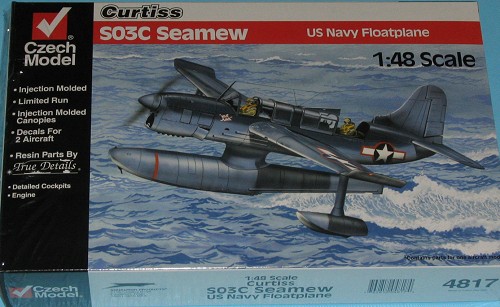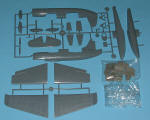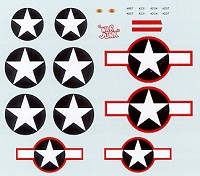
| KIT: | Czech Model 1/48 Curtiss SO3C 'Seamew' |
| KIT #: | 4817 |
| PRICE: | $49.95 (44.96 at Squadron) |
| DECALS: | Two options |
| REVIEWER: | Scott Van Aken |
| NOTES: | Short run with resin parts |

| HISTORY |
The SOC-3 'Seamew' was developed to replace the biplane SOC 'Seagull' that was used for naval artillery spotting and general utility service. A mid-winged monoplane powered by a Ranger in-line inverted 'vee' 12 cylinder air cooled engine, the aircraft was to have folding wing for shipboard storage and be able to operate on floats and wheels.
The prototype flew in late 1939 and was fraught with problems from the very beginning. The worst of them were engine cooling and stability. Increasing the opening in the engine cowling and adding more cooling flaps took care of the engine. The stability situation was remedied by enlarging the dorsal fin and adding upswept wing tips.
Production began in 1940 with the first plane leaving the assembly lines in early 1942. Approximately 350 were delivered to the US Navy with another 200 going to the British. Fleet service soon showed that the aircraft were not what was expected. Thanks to the growing weight, the aircraft could not take off from the water with a full fuel load. Excessive flexing often had the prop cut into the main float and the aircraft was involved in a number of accidents, most of which were undoubtedly caused by the lack of decent power.
The average life span on board ships was about two months with the type being replaced as soon as possible by refurbished SOC 'Seagull' biplanes. British experience was similarly poor with those aircraft often converted to land planes and used for utility work. 48 were bailed to the US Coast Guard, also in land plane configuration where they enjoyed limited success.
| THE KIT |
 This kit follows
very much in the mold of previous Czech Model kits. The major airframe
parts are in rather thick plastic with the detail pieces in resin. There is
a clear, but thick canopy provided that can only be displayed in the closed
position. Beaching gear is also given and it is similar to that used by the
Kingfisher, which attaches to the main float.
This kit follows
very much in the mold of previous Czech Model kits. The major airframe
parts are in rather thick plastic with the detail pieces in resin. There is
a clear, but thick canopy provided that can only be displayed in the closed
position. Beaching gear is also given and it is similar to that used by the
Kingfisher, which attaches to the main float.
Surface detailing is quite good with fine engraved detailing. I fear that some of this may well be destroyed during construction as one fills various seams. A nice touch is that the elevators are part of the upper horizontal tail plane piece, leaving a nice, thin trailing edge. It would be nice if this could also be done for the trailing edge of the wing as well.
The cockpit and observers station are both in resin. The cockpit has a full resin floor, side panels, seat, stick and rudder pedals along with a resin rear bulkhead that has a great deal of detail in it. The instrument panel/front bulkhead is also resin and includes nice instrument detail. There is also a near full lower resin engine section so that when you look through the forward cowling opening, you'll see some detail. The observer is provided with a complete bulkhead with all his radio gear as well as a very nice resin machine gun and mount.
 The rest of the kit
is quite straight-forward in terms of what is given. The wheels for the
beaching gear are molded as one part and are a touch mis-aligned so a bit
of sanding will be needed to round these out. As usual, the large pieces
have a few ejector pin towers that will need to be removed. The wings and
floats are all butt-joined so if you think you need more support, you'll
need to drill out areas for pins.
The rest of the kit
is quite straight-forward in terms of what is given. The wheels for the
beaching gear are molded as one part and are a touch mis-aligned so a bit
of sanding will be needed to round these out. As usual, the large pieces
have a few ejector pin towers that will need to be removed. The wings and
floats are all butt-joined so if you think you need more support, you'll
need to drill out areas for pins.
Instructions are quite good and provide detailed painting information in the 8 well-drawn construction steps. Markings are provided for two aircraft: one from the USS Denver in 1943 in the early war colors of blue-grey uppers and light grey undersides. The other is in the Tri-color scheme aboard the USS Biloxi in 1944. This later scheme has red surround insignia which were ordered repainted with a blue surround in September 1943. Decals are well printed and appear to be quite thin.
| CONCLUSIONS |
This is yet another of those planes that I never thought I'd see in 1/48. One really has to thank Czech Model for producing an aircraft like this as there are really no other sub-variants to do. Though there are not that many parts to the kit, I'll bet that it will require a bit of additional work to get just right. I know I'm looking forward to building it and there will be a full build review a bit on down the road.
November 2005
You can find this kit and many others at

If you would like your product reviewed fairly and quickly by a site that has around 300,000 visitors a month, please contact me or see other details in the Note to Contributors.